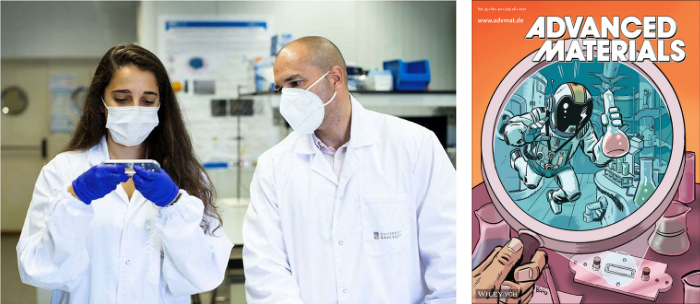
Left: Noemí Contreras-Pereda (ICN2) and Josep Puigmartí (IQTCUB-ICREA) with the microgravity Device. Credit: Xènia Fuentes/UB. Right: Image of the Advanced Materials front page, drawn by the comic illustrator Adrián Bago.
Cerdanyola del Vallès, 29 July, 2021. To get these simulated microgravity conditions, the researchers used custom-made microfluidic devices. These are instruments that use small quantities of fluids on a micro-chip to conduct laboratory tests. With these devices, they have created 2D (formed by one layer of atoms) porous crystalline molecular structures. According to Josep Puigmartí Luis, ICREA researcher at the Department of Physical Chemistry and member of the Institute of Theoretical and Computational Chemistry (IQTCUB), “we confirmed that the experiments under these simulated microgravity conditions have unprecedented effects on the orientation, compactness and generation of 2D crystalline and porous materials”.
To create this new system, the research team, which counts on the participation of members of the Catalan Institute of Nanoscience and Nanotechnology (ICN2) and the Institute of Materials Science of Barcelona (ICMAB-CSIC), designed a microfluidic device that consists of two interlinked substrates with a fine silicone film with variable thicknesses (from 200 to 500 μm). The objective was to create a microfluidic environment of 6cm long and 1.5cm wide. One of the surfaces has two machine inlet ports that enable the complete filling of the microfluidic environment and prevent the appearance of air bubbles. The system enabled the growth of a 2D metalorganic framework prototype (MOF), which forms a millimetric layer without defects with conductivity properties that act at a long distance under environmental conditions. The research group used the NCD-SWEET beamline from the ALBA Synchrotron to study crystallinity, structure and orientation of the created 2D material.
"The spatio-temporal control in the growth of this material obtained with the simulated microgravity conditions is unprecedented in the scientific literature. The microfluidic device has allowed us to develop centimetre-long thin layers and study the previously undescribed electronic properties of the material," explains Noemí Contreras Pereda, from ICN2.
To date, the obtained value with this new method had been achieved outside an inert atmosphere with pellets prepared under high pressures. “This new simulated microgravity system will be like a ‘playground’ for chemists, physicists, and materials scientists who want to process 2D functional devices and materials”, concludes the researcher.
Experiments at the ALBA Synchrotron
Experiments of 2D grazing incidence wide-angle X-ray scattering (GIWAXS) were performed at the NCD-SWEET beamline in ALBA, which helped to assess the crystallinity, structure and orientations of the samples. The results indicated that the layers of the metalorganic framework grew homogeneously on the substrate’s surface, confirming the microfluidic system as a new fabrication methodology to produce large, oriented, compact, smooth and crack-free crystalline films.
Reference: Noemí Contreras-Pereda, David Rodríguez-San-Miguel, Carlos Franco, Semih Sevim, João Pedro Vale, Eduardo Solano, Wye-Khay Fong, Alessandra Del Giudice, Luciano Galantini, Raphael Pfattner, Salvador Pané, Tiago Sotto Mayor, Daniel Ruiz-Molina, Josep Puigmartí-Luis. Synthesis of 2D Porous Crystalline Materials in Simulated Microgravity. Advanced Materials (2021). DOI: https://doi.org/10.1002/adma.202170231
Link to the original news:
- University of Barcelona: https://www.ub.edu/web/ub/en/menu_eines/noticies/2021/06/043.html
- Catalan Institute of Nanoscience and Nanotechnology: https://icn2.cat/en/news/4746-space-laboratories-conditions-simulated-on-earth-allow-synthesising-high-quality-2d-crystalline-materials




